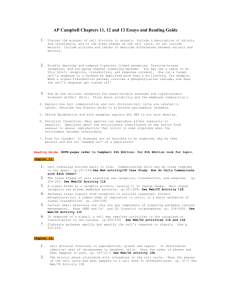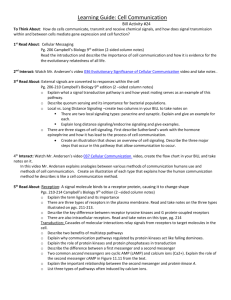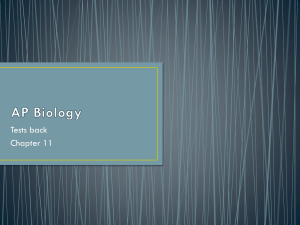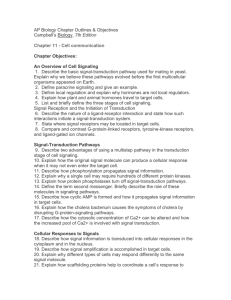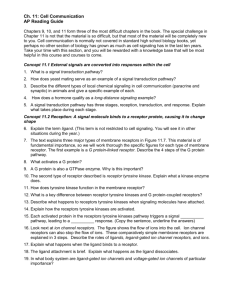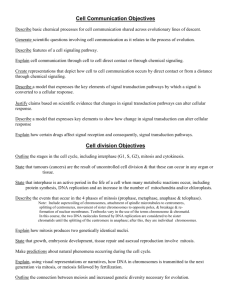Principles of Biology ______Lake Tahoe
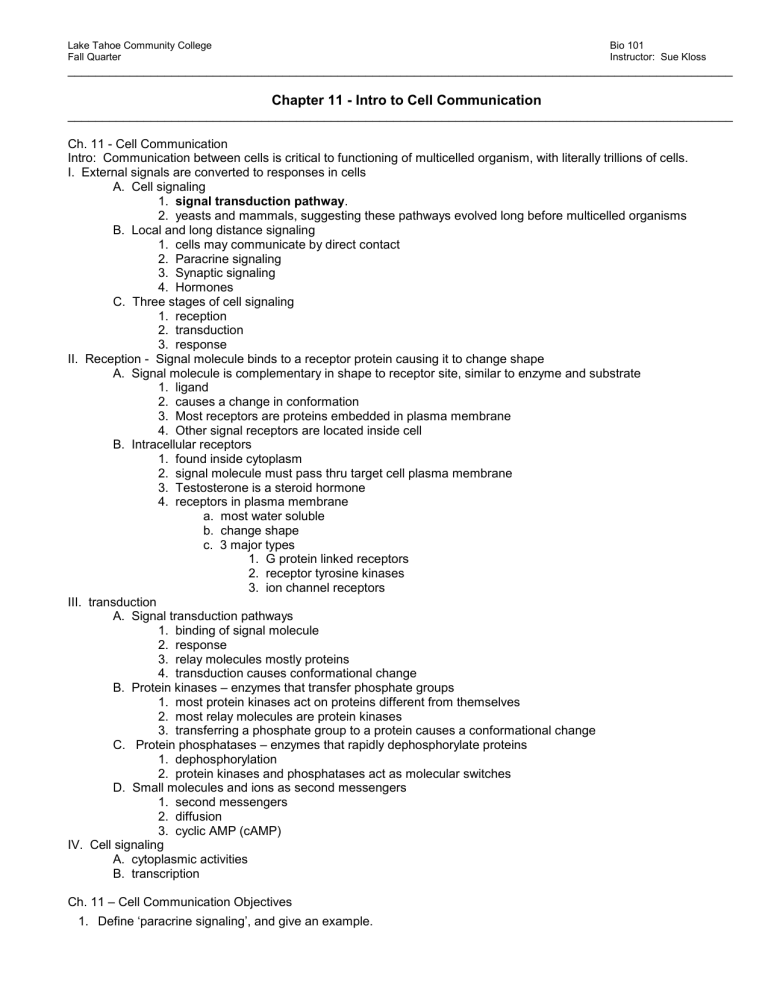
Lake Tahoe Community College
Fall Quarter
Bio 101
Instructor: Sue Kloss
________________________________________________________________________________________________
Chapter 11 - Intro to Cell Communication
________________________________________________________________________________________________
Ch. 11 - Cell Communication
Intro: Communication between cells is critical to functioning of multicelled organism, with literally trillions of cells.
I. External signals are converted to responses in cells
A. Cell signaling
1. signal transduction pathway .
2. yeasts and mammals, suggesting these pathways evolved long before multicelled organisms
B. Local and long distance signaling
1. cells may communicate by direct contact
2. Paracrine signaling
3. Synaptic signaling
4. Hormones
C. Three stages of cell signaling
1. reception
2. transduction
3. response
II. Reception - Signal molecule binds to a receptor protein causing it to change shape
A. Signal molecule is complementary in shape to receptor site, similar to enzyme and substrate
1. ligand
2. causes a change in conformation
3. Most receptors are proteins embedded in plasma membrane
4. Other signal receptors are located inside cell
B. Intracellular receptors
1. found inside cytoplasm
2. signal molecule must pass thru target cell plasma membrane
III. transduction
3. Testosterone is a steroid hormone
4. receptors in plasma membrane a. most water soluble b. change shape c. 3 major types
1. G protein linked receptors
2. receptor tyrosine kinases
3. ion channel receptors
A. Signal transduction pathways
1. binding of signal molecule
2. response
3. relay molecules mostly proteins
4. transduction causes conformational change
B. Protein kinases – enzymes that transfer phosphate groups
1. most protein kinases act on proteins different from themselves
2. most relay molecules are protein kinases
3. transferring a phosphate group to a protein causes a conformational change
C. Protein phosphatases – enzymes that rapidly dephosphorylate proteins
1. dephosphorylation
2. protein kinases and phosphatases act as molecular switches
D. Small molecules and ions as second messengers
1. second messengers
2. diffusion
3. cyclic AMP (cAMP)
IV. Cell signaling
A. cytoplasmic activities
B. transcription
Ch. 11 – Cell Communication Objectives
1.
Define ‘paracrine signaling’, and give an example.
2.
Define local regulation and explain why hormones are not local regulators.
3.
Explain how animal hormones travel to target cells.
4.
Describe the nature of a ligand-receptor interaction and state how such interactions initiate a signaltransduction system.
5.
6.
List and briefly describe at least 2 places where signal receptors may be located in target cells.
Compare and contrast G-protein-linked receptors, tyrosine-kinase receptors, and ligand-gated ion channels.
7.
Describe two advantages of using a multistep pathway in the transduction stage of cell signaling.
8.
Explain how the original signal molecule can produce a cellular response when it may not even enter the target cell.
9.
Describe how phosphorylation propagates signal information.
10.
Explain why a single cell may require hundreds of different protein kinases.
11.
Explain how protein phosphatases turn off signal-transduction pathways.
12.
13.
Define the term ‘second messenger’. Briefly describe the role of these molecules in signaling pathways.
What are the main 2 results of signal transduction pathways? Give examples of each.
Lake Tahoe Community College
Fall Quarter
Bio 101
Instructor: Sue Kloss
________________________________________________________________________________________________
Chapter 12 - Intro to Cell Division
________________________________________________________________________________________________
Ch. 12 - The cell cycle
Intro. Development, from a fertilized egg to new adult, is one phase of the life cycle - sequence of life stages leading from one adult to the next
1. new individual first appears as a fertilzed egg
2. sexual reproduction
3. sperm and egg each carry one set of genetic information
4. offspring of sex inherit traits from both parents
5. asexual reproduction
6. Cell division is nec. for sexual or asexual repro
I. Connections between cell division and reproduction
A. Like begets like , more or less
1. only people beget people
2. asexual reproduction
3. chromosomes are the structures that contain most of the organisms DNA
4. amoeba reproduces asexually, a. the chromosomes are duplicated b. when parent divides, daughter cells are identical
5. in sexually reproducing species, offspring generally resemble parents a. each offspring inherits a unique combination b. sexual reproduction results in great variety in offspring
B. cells arise only from preexisting cells
II. Eukaryotic Cell Cycle and Mitosis
A. large complex chromosomes of eukaryotes duplicate with each cell division
1. eukaryotic cells are more complex and genly much larger than prokaryotes,
2. and have many more genes - genome
3. genes are grouped into nucleus and found on chromosomes
4. chromosomes are chromatin about to undergo division
5. eukaryotic chromosome contains one long DNA molecule
6. well before division, a cell duplicates its chromosomes
B. Cell cycle multiplies cells
1. cell division enables organisms to grow
2. keeps total number in your body constant
3. cell cycle a. interphase b. DNA duplication occurs in (approx) the middle of interphase
4. cell division consists of 2 processes
5. mitosis is unique to eukaryotes
C. Cell division is continuum of dynamic changes
1. Interphase
2. prophase
3. prometaphase
4. metaphase
5. anaphase
6. telophase and cytokinesis
D. Cytokinesis differs for plant and animal cells
1. animals
2. plants
E. anchorage, cell density and chemical growth factors affect cell division
1. for normal growth and development, timing of cell divsion must be controlled
2. most plant and animal cells won’t divide unless anchored
3. cells won’t divide if they are touching another cell
F. growth factors signal cell cycle control system
III. Cell Cycle is regulated by a molecular control system
A. growth factors signal cell cycle control system
1. animals cells are generally anchored and bathed in nutrients provided by blood
a. growth factors are main signals
2. cell cycle control system = cyclically operating set of proteins
3. most animal cells have built in breaks that stop cell cycle
4. 3 key checkpoints
B. Cyclins and Cyclin-dependent kinases
C. Stop and Go Signs: internal and external signals at checkpoints
1. researchers working out links btn various cdk/cyclin complexes
2. internal signals
3. external factors that regulate cell cycle
4. Other external cues are anchorage and cell density
5. most plant and animal cells won’t divide unless in contact with solid surface to anchor
6. cells won’t divide if they are touching another cell (Density dependent inhibition)
D. Cancers - uncontrolled growth
1. benign tumors
2. malignant tumors
3. types of cancers
4. ignore growth factor or manufacture it themselves
5. ignore density dependence, reduced need for anchorage – metastasis
6. normal cells divide in culture for 50 generations, cancers indefinitely
7. radiation damages cells that divide quickly
Ch. 12 – Cell Cycle – Lesson Objectives
1. Explain how cell division functions in reproduction, growth, and repair.
2. Describe the structural organization of a prokaryotic and eukaryotic genome.
3. Describe the major events of cell division that enable the genome of one cell to be passed on to two daughter cells.
4. Describe how the chromosome number changes throughout the human life cycle.
5. Draw and label the phases of the cell cycle and describe the sequence of events that occurs during each phase.
6. List the phases of mitosis and describe the events characteristic of each phase.
7. Identify the phases of mitosis from diagrams and micrographs.
8. Draw or describe the spindle apparatus, including centrosomes, kinetochore microtubules, nonkinetochore microtubules, asters, and centrioles (in animal cells).
9. Draw, label, and briefly describe the characteristic changes that occur in the spindle apparatus during each phase of mitosis.
10. Compare cytokinesis in animals and plants.
11. Describe the process of binary fission in bacteria .
12. Describe the roles of checkpoints, cyclin, Cdk, and MPF in the cell cycle control system.
13. Describe the internal and external factors that influence the cell cycle control system.
14. Explain how the abnormal cell division of cancerous cells escapes normal cell cycle controls.



